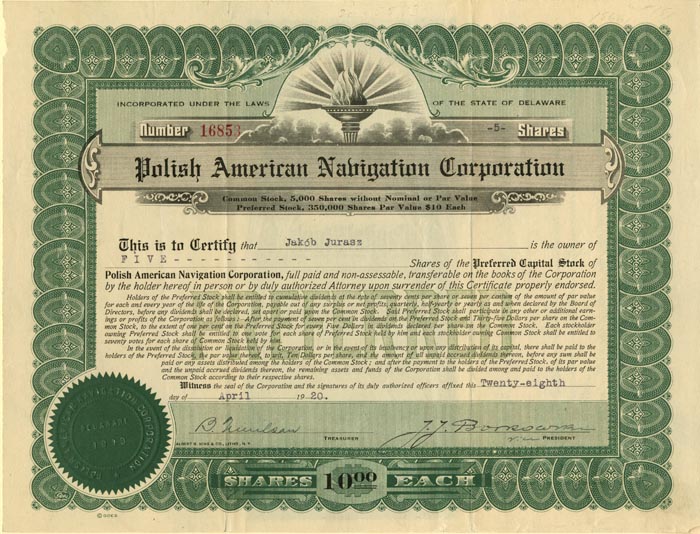Polish American Navigation Corporation - Stock Certificate
Inv# SS1236 Stock
Stock printed by Goes. "Polish American". Tear repairs at bottom.
Navigation is a field of study that focuses on the process of monitoring and controlling the movement of a craft or vehicle from one place to another. The field of navigation includes four general categories: land navigation, marine navigation, aeronautic navigation, and space navigation.
It is also the term of art used for the specialized knowledge used by navigators to perform navigation tasks. All navigational techniques involve locating the navigator's position compared to known locations or patterns.
Navigation, in a broader sense, can refer to any skill or study that involves the determination of position and direction. In this sense, navigation includes orienteering and pedestrian navigation.
In the European medieval period, navigation was considered part of the set of seven mechanical arts, none of which were used for long voyages across open ocean. Polynesian navigation is probably the earliest form of open-ocean navigation, it was based on memory and observation recorded on scientific instruments like the Marshall Islands Stick Charts of Ocean Swells. Early Pacific Polynesians used the motion of stars, weather, the position of certain wildlife species, or the size of waves to find the path from one island to another.
Maritime navigation using scientific instruments such as the mariner's astrolabe first occurred in the Mediterranean during the Middle Ages. Although land astrolabes were invented in the Hellenistic period and existed in classical antiquity and the Islamic Golden Age, the oldest record of a sea astrolabe is that of Majorcan astronomer Ramon Llull dating from 1295. The perfecting of this navigation instrument is attributed to Portuguese navigators during early Portuguese discoveries in the Age of Discovery. The earliest known description of how to make and use a sea astrolabe comes from Spanish cosmographer Martín Cortés de Albacar's Arte de Navegar (The Art of Navigation) published in 1551, based on the principle of the archipendulum used in constructing the Egyptian pyramids.
Open-seas navigation using the astrolabe and the compass started during the Age of Discovery in the 15th century. The Portuguese began systematically exploring the Atlantic coast of Africa from 1418, under the sponsorship of Prince Henry. In 1488 Bartolomeu Dias reached the Indian Ocean by this route. In 1492 the Spanish monarchs funded Christopher Columbus's expedition to sail west to reach the Indies by crossing the Atlantic, which resulted in the Discovery of the Americas. In 1498, a Portuguese expedition commanded by Vasco da Gama reached India by sailing around Africa, opening up direct trade with Asia. Soon, the Portuguese sailed further eastward, to the Spice Islands in 1512, landing in China one year later.
The first circumnavigation of the earth was completed in 1522 with the Magellan-Elcano expedition, a Spanish voyage of discovery led by Portuguese explorer Ferdinand Magellan and completed by Spanish navigator Juan Sebastián Elcano after the former's death in the Philippines in 1521. The fleet of seven ships sailed from Sanlúcar de Barrameda in Southern Spain in 1519, crossed the Atlantic Ocean and after several stopovers rounded the southern tip of South America. Some ships were lost, but the remaining fleet continued across the Pacific making a number of discoveries including Guam and the Philippines. By then, only two galleons were left from the original seven. The Victoria led by Elcano sailed across the Indian Ocean and north along the coast of Africa, to finally arrive in Spain in 1522, three years after its departure. The Trinidad sailed east from the Philippines, trying to find a maritime path back to the Americas, but was unsuccessful. The eastward route across the Pacific, also known as the tornaviaje (return trip) was only discovered forty years later, when Spanish cosmographer Andrés de Urdaneta sailed from the Philippines, north to parallel 39°, and hit the eastward Kuroshio Current which took its galleon across the Pacific. He arrived in Acapulco on October 8, 1565.
A stock certificate is issued by businesses, usually companies. A stock is part of the permanent finance of a business. Normally, they are never repaid, and the investor can recover his/her money only by selling to another investor. Most stocks, or also called shares, earn dividends, at the business's discretion, depending on how well it has traded. A stockholder or shareholder is a part-owner of the business that issued the stock certificates.










Ebay ID: labarre_galleries